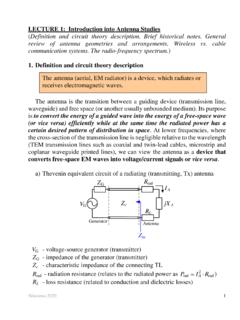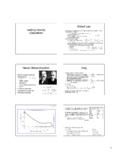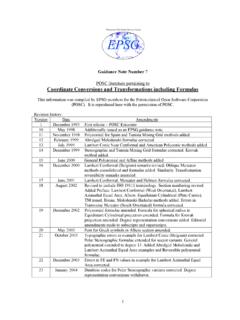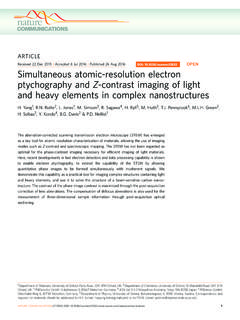Transcription of LECTURE 12: Reflector Antennas - McMaster …
1 Nikolova 2016 1 LECTURE 19: Reflector Antennas 1. Introduction High-gain Antennas are required for long-distance radio communications (radio-relay links and satellite links), high-resolution radars, radio-astronomy, etc. Reflector systems are probably the most widely used high-gain Antennas . They can easily achieve gains of above 30 dB for microwave and higher frequencies. Reflector Antennas operate on principles known long ago from geometrical optics (GO). The first RF Reflector system was made by Hertz back in 1888 (a cylindrical Reflector fed by a dipole). However, the art of accurately designing such antenna systems was developed mainly during the days of WW2 when numerous radar applications evolved. M INTELSAT EARTH STATION (ANT BOSCH TELECOM), DUAL Reflector Nikolova 2016 2 AIRCRAFT RADAR RADIO RELAY TOWER Nikolova 2016 3 FEED-HORN IS IN FOCAL POINT CONICAL HORN PRIMARY FEED Nikolova 2016 4 The simplest Reflector antenna consists of two components: a reflecting surface and a much smaller feed antenna at the Reflector s focal point.
2 Constructions that are more complex involve a secondary Reflector (a subreflector) at the focal point, which is illuminated by a primary feed. These are called dual- Reflector Antennas . The most common main Reflector is the parabolic one. Other common reflectors are: cylindrical, corner, and spherical. 2. Principles of parabolic reflectors [Stutzman&Thiele] A paraboloidal surface is described by the equation (see plot b) 24 (),fFF za = . ( ) Here, is the distance from a point A to the focal point O, where A is the projection of the point R on the Reflector surface onto the axis-orthogonal plane (the aperture plane) at the focal point. For a given displacement from the axis of the Reflector , the point R on the Reflector surface is a distance fr away from the focal point O. The position of R can be defined either by (, )fz , which is a rectangular pair of coordinates, or by (, )ffr , which is a polar pair of coordinates.
3 A relation between (, )ffr and F is readily found from ( ): Nikolova 2016 5 221 coscos (/ 2)fffFFr ==+. ( ) This is the equation of the paraboloidal surface in polar coordinates. Other relations to be used later are: 2 sinsin2 tan1 cos2fffffFrF === + . ( ) The axisymmetric (rotationally symmetric) paraboloidal Reflector is entirely defined by the respective parabolic line, , by two basic parameters: the diameter D and the focal length F (see plot b). Often, the parabola is specified in terms of D and the ratio F/D. When F/D approaches infinity, the Reflector becomes flat. Some parabolic curves are shown below. When , the focal point lies in the plane passing through the Reflector s rim. The angle from the feed (focal) point to the Reflector s rim is related to /FD as F/D=1/3 F/D=1/2 Focal point 0 Nikolova 2016 6 012 arctan4( /)FD =.
4 ( ) The focal distance F of a given Reflector can be calculated after measuring its diameter D and its height 0H (see plot b): 2016 DFH=. ( ) Eq. ( ) is found by solving ( ) with /2D = and 0fz FH= . For example, if /1/ 4FD=, then 00/4 HDHF= =, , the focal point is on the Reflector s rim plane. The Reflector design problem aims at matching the feed antenna pattern to the Reflector . Usually, the feed pattern must be at about a 10 dB level in the direction of the rim, 0()10fF = = dB ( of the normalized amplitude pattern). The geometry of the paraboloidal Reflector has two valuable features: All rays leaving the focal point O are collimated along the Reflector s axis after reflection. All overall ray path lengths (from the focal point to the Reflector and on to the aperture plane) are the same and equal to 2F.
5 The above properties are proven by the GO methods, therefore, they are true only if the following conditions hold: The radius of the curvature of the Reflector is large compared to the wavelength and the local region around each reflection point can be treated as planar. The radius of the curvature of the incoming wave from the feed is large and can be treated locally at the reflection point as a plane wave. The Reflector is a perfect conductor, , 1 = . The collimating property of the parabolic Reflector is easily established after finding the unit normal of the parabola, ppCC = n. ( ) Here, Nikolova 2016 7 ()2cos/ 20pffC Fr = = ( ) is the parabolic curve equation [see ( )]. After applying the operator in spherical coordinates, pC is obtained as 2 coscossin222fffpffC = + r , ( ) and, therefore, cossin22ffff = +nr.
6 ( ) The angle between n and the incident ray is coscos2fif = = rn. ( ) According to Snell s law, ir =. It is easy to show that this is fulfilled only if the ray is reflected in the z-direction: cos(cossin)cossin22coscossinsincos .222ffrf ff ffffffff = = + += = + = znznr r ( ) Thus, we proved that for any angle of incidence f the reflected wave is z-directed. The equal-path-length property follows from ( ). The total path-length L for a ray reflected at the point R is cos(1 cos)2fff ffLORRAr rrF =+=+= + =. ( ) Notice that L is a constant equal to 2F regardless of the angle of incidence. Nikolova 2016 8 3. Aperture distribution analysis via GO (aperture integration) There are two basic techniques for the analysis of the radiation characteristics of reflectors. One is called the current distribution method, which is a physical optics (PO) approximation.
7 It assumes that the incident field from the feed is known, and that it excites surface currents on the Reflector s surface as 2is= JnH. This current density is then integrated to yield the far-zone field. It is obvious that the PO method assumes that the Reflector has a perfectly conducting surface and makes use of image theory. Besides, it assumes that the incident wave coming from the primary feed is a locally plane far-zone field. With the aperture distribution method, the field is first found over a plane, which is normal to the Reflector s axis, and lies at its focal point (the antenna aperture). GO (ray tracing) is used to do that. Equivalent sources are formed over the aperture plane. It is assumed that the equivalent sources are zero outside the Reflector s aperture. We first consider this method.
8 The field distribution at the aperture of the Reflector antenna is necessary in order to calculate the far-field pattern, directivity, etc. Since all rays from the feed travel the same physical distance to the aperture, the aperture distribution is of uniform phase. However, there is a non-uniform amplitude distribution. This is because the power density of the rays leaving the feed falls off as 21/fr. After the reflection, there is practically no spreading loss since the rays are collimated (parallel). The aperture field-amplitude distribution varies as 1/fr. This is explained in detail below. Nikolova 2016 9 GO assumes that the power density in free space follows straight paths. Applied to the power transmitted by the feed, the power in a conical wedge stays confined within as it progresses along the cone s axis.
9 Consider a conical wedge of solid angle d whose cross-section angle is fd . It confines power, which after being reflected from the paraboloid, arrives at the aperture plane confined within a cylindrical ring of thickness d and area 2dAd =. Let us assume that the feed is isotropic and it has radiation intensity /4tU = , where t is the transmitted power. The power confined in the conical wedge is (/4 )tdUdd = = . This power reaches the aperture with a density of ()4taddPdAdA = =. ( ) The generic relation between the solid angle increment and the directional-angle increments is sinddd =, ( ) (see LECTURE 4). In this case, the structure is rotationally symmetric, so we define the solid angle of the conical wedge as z Nikolova 2016 10 20(sin)2 sinff fffdddd == . ( ) The substitution of ( ) and 2dAd = in ( ) produces 2 sinsin()424fff fttaddPdd ==.
10 ( ) From ( ), it is seen that 2cos (/ 2)fffdFrd ==, ( ) 1ffddr = , ( ) 2sin11()4sin4fttaffffPr rr == . ( ) Equation ( ) shows the spherical nature of the feed radiation, and it is referred to as spherical spreading loss. Since aaEP , 1afEr . ( ) If the primary feed is not isotropic, the effect of its normalized field pattern (, )ff fF is easily incorporated in ( ) as (, )ff fafFEr . ( ) Thus, we can conclude that the field at the aperture is described as 2(, )(, )ff fjFaf fmfFEEer = . ( ) The coordinates (,) are more suitable for the description of the aperture field. Obviously, f . As for fr and f , they are transformed as 2244fFrF +=, ( ) Nikolova 2016 11 2 arctan2fF =. ( ) The last thing to be determined is the polarization of the aperture field provided the polarization of the primary-feed field is known.













